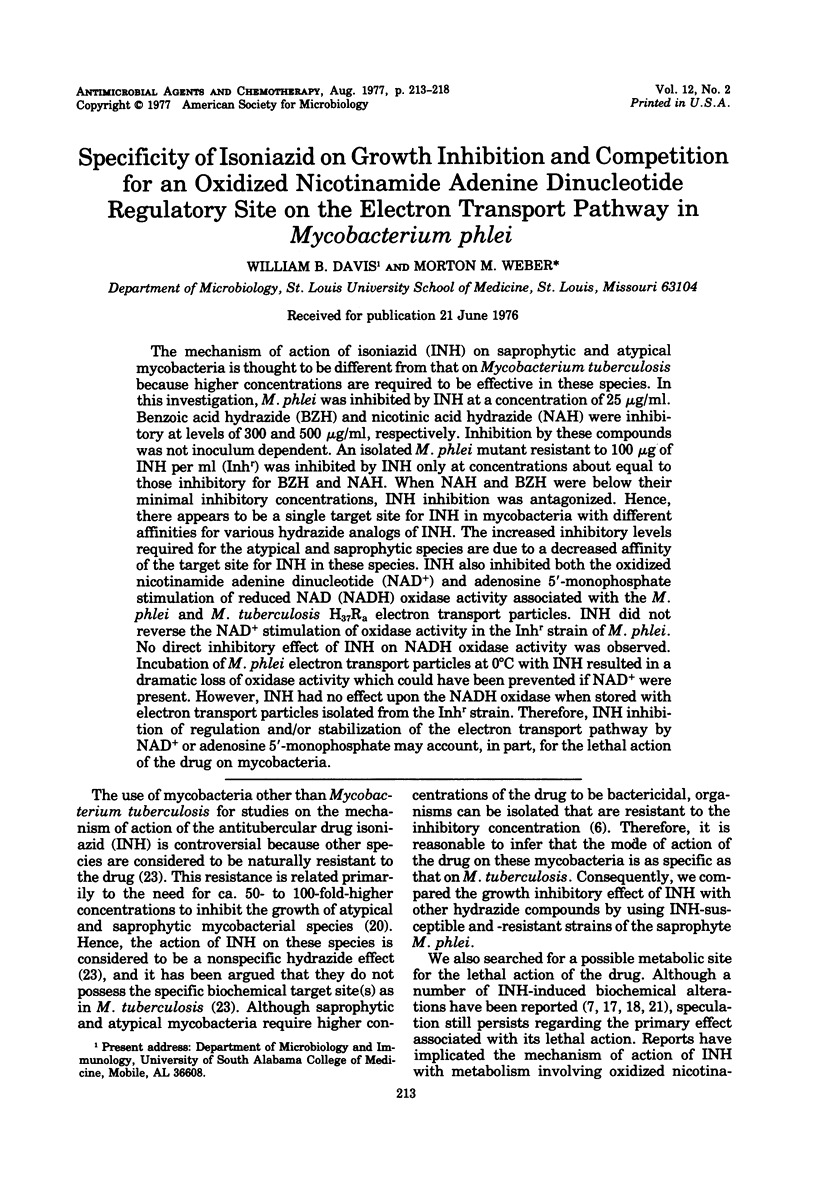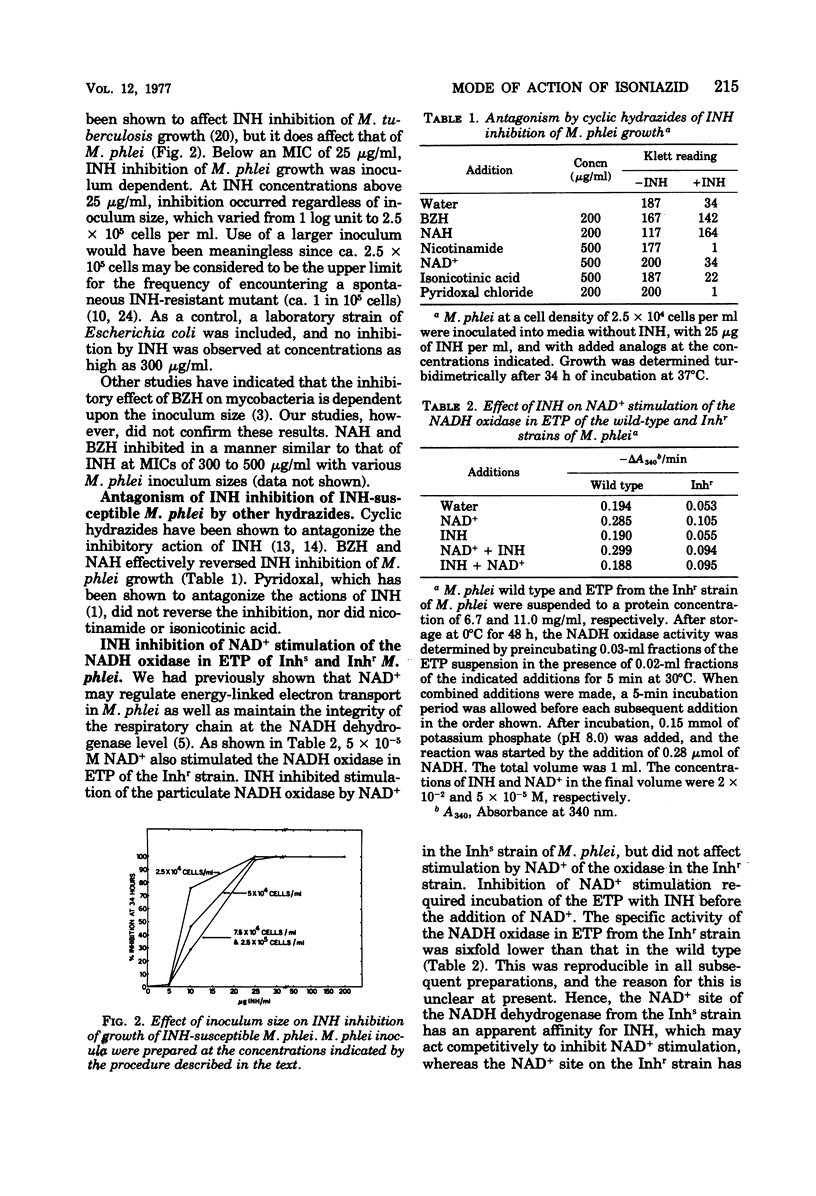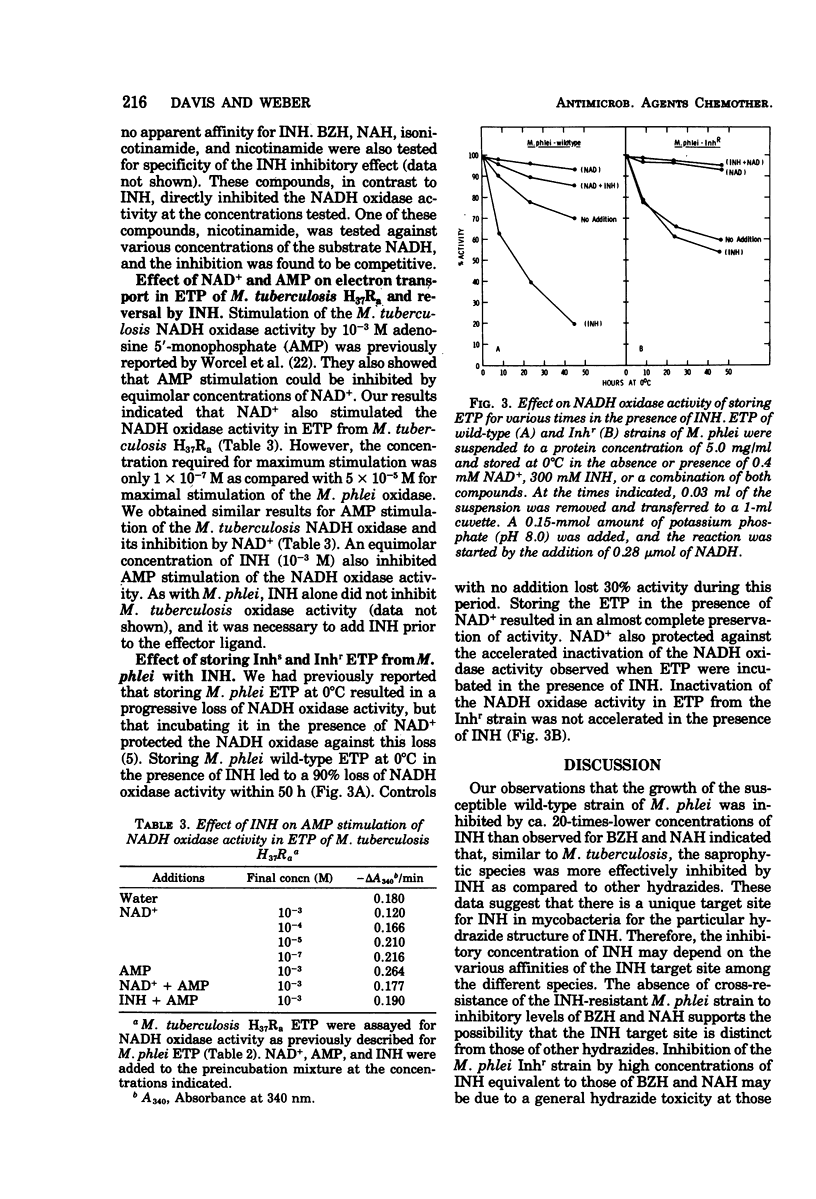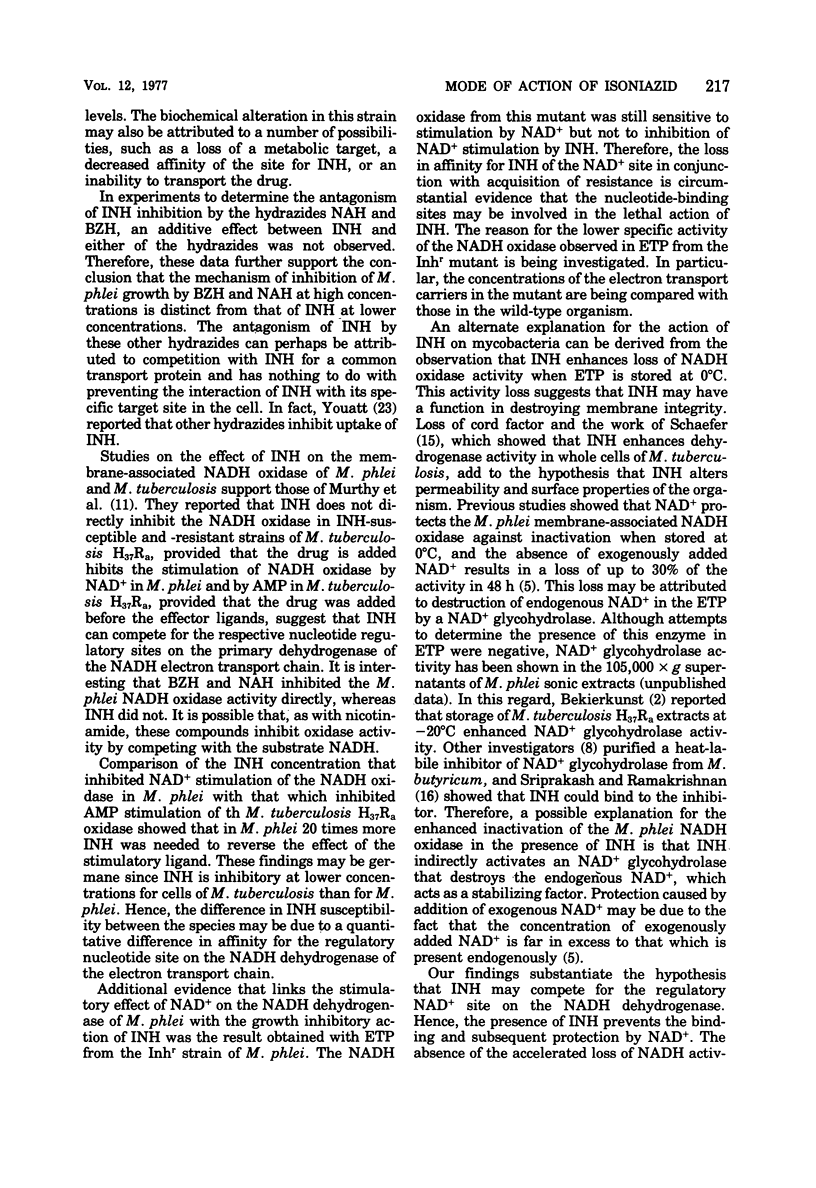Abstract
The mechanism of action of isoniazid (INH) on saprophytic and atypical mycobacteria is thought to be different from that on Mycobacterium tuberculosis because higher concentrations are required to be effective in these species. In this investigation, M. phlei was inhibited by INH at a concentration of 25 μg/ml. Benzoic acid hydrazide (BZH) and nicotinic acid hydrazide (NAH) were inhibitory at levels of 300 and 500 μg/ml, respectively. Inhibition by these compounds was not inoculum dependent. An isolated M. phlei mutant resistant to 100 μg of INH per ml (Inhr) was inhibited by INH only at concentrations about equal to those inhibitory for BZH and NAH. When NAH and BZH were below their minimal inhibitory concentrations, INH inhibition was antagonized. Hence, there appears to be a single target site for INH in mycobacteria with different affinities for various hydrazide analogs of INH. The increased inhibitory levels required for the atypical and saprophytic species are due to a decreased affinity of the target site for INH in these species. INH also inhibited both the oxidized nicotinamide adenine dinucleotide (NAD+) and adenosine 5′-monophosphate stimulation of reduced NAD (NADH) oxidase activity associated with the M. phlei and M. tuberculosis H37Ra electron transport particles. INH did not reverse the NAD+ stimulation of oxidase activity in the Inhr strain of M. phlei. No direct inhibitory effect of INH on NADH oxidase activity was observed. Incubation of M. phlei electron transport particles at 0°C with INH resulted in a dramatic loss of oxidase activity which could have been prevented if NAD+ were present. However, INH had no effect upon the NADH oxidase when stored with electron transport particles isolated from the Inhr strain. Therefore, INH inhibition of regulation and/or stabilization of the electron transport pathway by NAD+ or adenosine 5′-monophosphate may account, in part, for the lethal action of the drug on mycobacteria.
Full text
PDF





Selected References
These references are in PubMed. This may not be the complete list of references from this article.
- BONICKE R. Untersuchungen über die antikatalatische Wirkung des Isoniazids bei Mycobakterien. Z Hyg Infektionskr. 1956;142(4):347–362. [PubMed] [Google Scholar]
- BRODIE A. F., GRAY C. T. Phosphorylation coupled to oxidation in bacterial extracts. J Biol Chem. 1956 Apr;219(2):853–862. [PubMed] [Google Scholar]
- Beggs W. H., Jenne J. W. Mechanism for the pyridoxal neutralization of isoniazid action of Mycobacterium tuberculosis. J Bacteriol. 1967 Oct;94(4):793–797. doi: 10.1128/jb.94.4.793-797.1967. [DOI] [PMC free article] [PubMed] [Google Scholar]
- Davis W. B., Zlotnick B. J., Weber M. M. Effect of nicotinamide adenine dinucleotide on the membrane-associated reduced nicotinamide adenine dinucleotide oxidase of Mycobacterium phlei. J Biol Chem. 1975 Mar 10;250(5):1648–1654. [PubMed] [Google Scholar]
- Fishbain D., Ling G., Kushner D. J. Isoniazid metabolism and binding by sensitive and resistant strains of Mycobacterium smegmatis. Can J Microbiol. 1972 Jun;18(6):783–792. doi: 10.1139/m72-123. [DOI] [PubMed] [Google Scholar]
- GANGADHARAM P. R., HAROLD F. M., SCHAEFER W. B. Selective inhibition of nucleic acid synthesis in Mycobacterium tuberculosis by isoniazid. Nature. 1963 May 18;198:712–714. doi: 10.1038/198712b0. [DOI] [PubMed] [Google Scholar]
- KERN M., NATALE R. A diphosphopyridine nucleotidase and its protein inhibitor from Mycobacterium butyricum. J Biol Chem. 1958 Mar;231(1):41–51. [PubMed] [Google Scholar]
- LOWRY O. H., ROSEBROUGH N. J., FARR A. L., RANDALL R. J. Protein measurement with the Folin phenol reagent. J Biol Chem. 1951 Nov;193(1):265–275. [PubMed] [Google Scholar]
- MITCHISON D. S. Titration of strains of tubercle bacilli against isoniazid. Lancet. 1952 Nov 1;2(6740):858–860. doi: 10.1016/s0140-6736(52)91743-1. [DOI] [PubMed] [Google Scholar]
- Murthy P. S., Sirsi M., Ramakrishnan T. Effect of isoniazid on the carbohydrate metabolism of isoniazid-susceptible and isoniazid-resistant Mycobacterium tuberculosis H37Rv. Am Rev Respir Dis. 1973 Jan;107(1):139–141. doi: 10.1164/arrd.1973.107.1.139. [DOI] [PubMed] [Google Scholar]
- Ramakrishnan T., Murthy P. S., Gopinathan K. P. Intermediary metabolism of mycobacteria. Bacteriol Rev. 1972 Mar;36(1):65–108. doi: 10.1128/br.36.1.65-108.1972. [DOI] [PMC free article] [PubMed] [Google Scholar]
- SCHAEFER W. B. Effect of isoniazid on the dehydrogenase activity of Mycobacterium tuberculosis. J Bacteriol. 1960 Feb;79:236–245. doi: 10.1128/jb.79.2.236-245.1960. [DOI] [PMC free article] [PubMed] [Google Scholar]
- Sriprakash K. S., Ramakrishnan T. Isoniazid-resistant mutants of Mycobacterium tuberculosis H37RV: uptake of isoniazid and the properties of NADase inhibitor. J Gen Microbiol. 1970 Jan;60(1):125–132. doi: 10.1099/00221287-60-1-125. [DOI] [PubMed] [Google Scholar]
- TSUKAMURA M., TSUKAMURA S. EFFECT OF ISONIAZID ON PROTEIN SYNTHESIS OF MYCOBACTERIA. Am Rev Respir Dis. 1964 Apr;89:572–574. doi: 10.1164/arrd.1964.89.4.572. [DOI] [PubMed] [Google Scholar]
- Takayama K., Wang L., David H. L. Effect of isoniazid on the in vivo mycolic acid synthesis, cell growth, and viability of Mycobacterium tuberculosis. Antimicrob Agents Chemother. 1972 Jul;2(1):29–35. doi: 10.1128/aac.2.1.29. [DOI] [PMC free article] [PubMed] [Google Scholar]
- WEBER M. M., HOLLOCHER T. C., ROSSO G. THE APPEARANCE AND GENERAL PROPERTIES OF FREE RADICALS IN ELECTRON TRANSPORT PARTICLES FROM MYCOBACTERIUM PHLEI. J Biol Chem. 1965 Apr;240:1776–1782. [PubMed] [Google Scholar]
- WORCEL A., GOLDMAN D. S., CLELAND W. W. AN ALLOSTERIC REDUCED NICOTINAMIDE ADENINE DINUCLEOTIDE OXIDASE FROM MYCOBACTERIUM TUBERCULOSIS. J Biol Chem. 1965 Aug;240:3399–3407. [PubMed] [Google Scholar]
- YOUMANS A. S., YOUMANS G. P. The inactivation of isoniazid by filtrates and extracts of mycobacteria. Am Rev Tuberc. 1955 Aug;72(2):196–203. doi: 10.1164/artpd.1955.72.2.196. [DOI] [PubMed] [Google Scholar]
- Youatt J. A review of the action of isoniazid. Am Rev Respir Dis. 1969 May;99(5):729–749. doi: 10.1164/arrd.1969.99.5.729. [DOI] [PubMed] [Google Scholar]


